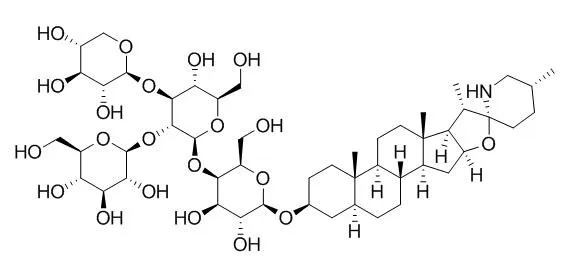| In vitro: |
| J Steroid Biochem Mol Biol . 2017 Jul;171:178-186. | | Neurotoxicity of the steroidal alkaloids tomatine and tomatidine is RIP1 kinase- and caspase-independent and involves the eIF2α branch of the endoplasmic reticulum[Pubmed: 28300624] | | Abstract
Steroidal alkaloids are a class of natural products that occur in several species of the Solanaceae family. In the case of the tomato plant (Lycopersicon esculentum Mill.), Tomatine and its aglycone, tomatidine, are the most representative molecules. These steroidal alkaloids have already shown several potentially useful biological activities, from anticancer to anti-inflammatory or antibacterial. In this work, the toxicity of these molecules in neuronal cells, namely in the neuroblastoma cell line SH-SY5Y, was assessed, emphasis being given to the cellular mechanisms underlying the effects observed. The results show that Tomatine/tomatidine-induced cell death is caspase- and RIP1 kinase-independent, as cell death is not prevented by the pan-caspase inhibitor Z-VAD.fmk or by RIP1 inhibitor necrostatin-1. Analysis of Ca2+ levels using the fluorescent probe Fura-2/AM indicates that both Tomatine and tomatidine have a marked effect upon Ca2+ homeostasis by increasing cytosolic Ca2+, an event that might be associated with their effect upon the endoplasmic reticulum. We show that the toxicity of these molecules require the PERK/eIF2α branch of the unfolded protein response, but not the IRE1α branch. Given the role of the endoplasmic reticulum in proteostasis, the ability of these molecules to inhibit the proteasome was also evaluated. Tomatine was able to inhibit the chymotrypsin-like catalytic core of purified human 20S proteasome, as shown by its ability to prevent degradation of the fluorogenic substrate Suc-Leu-Leu-Val-Tyr-AMC, thus suggesting that interference with proteostasis can be responsible for the toxicity of these steroidal alkaloids. This study is relevant as it sheds a light regarding the toxicity of molecules present in one of the most consumed plants worldwide.
Keywords: Calcium; Cell death mechanisms; Neurotoxicity: unfolded protein response; Steroidal alkaloids. |
|
| In vivo: |
| Acta Chir. Orthop. Traumatol. Cech.,2009,76(4):314-8. | | Alpha-tomatine induces apoptosis and inhibits nuclear factor-kappa B activation on human prostatic adenocarcinoma PC-3 cells.[Pubmed: 19755056] | One of the methods used for treatment of Kienböck's disease is based on transposition of the pisiform bone into free space created by removal of the lunate bone. It is performed in patients with stage IIIB to IV, as assessed by Lichtmann's score. However, this operative procedure has so far lacked an unequivocal assessment of its therapeutic value. The aim of our work was to assess the therapeutic effect of the Kuhlmann method in the treatment of advanced stages of Kienböck's disease.
METHODS AND RESULTS:
From January 1996, eighteen patients (18 wrists) diagnosed with Kienböck's disease were operated on, using the Kuhlmann method, and the group of these patients was included in this follow-up study. The average follow-up time was 7.6 +/- 2.3 years.
The results were evaluated on the basis of subjective (VAS) and functional criteria (ROM, grip force, DASH questionnaire and combined Cooney score questionnaires) and radiological assessment (arthritis evaluation, C.H.I., Natrass index, RSA).
All patients experienced pain relief. The average pain assessment by VAS (10-point scale) before and after the procedure was 8.76 +/- 0.9 and 2.94 +/- 1.59, respectively. The range of motion was reduced on the operated extremity (70% compared to non-operated) as well as the grip test (57%). The average DASH score at the time of study was 20.9 +/- 12.2 and the average Cooney score was 67.6 +/- 17.4. Before the operation, eleven wrists showed signs of osteoarthritis. At the follow-up evaluation, arthritis was present in fifteen patients.We found a significant difference in average radiological parameters characterizing a carpal collapse deformity (C.H.I., Natrass index, RSA) - all parameters showed deteriorating tendencies.
In nine patients, necrotic changes of the lunate occurred. In the patients whose pisiforme was not affected, a moderate retardation of carpal collapse occurred. However, the discrepancy between relevant indicators (C.H.I, Natrass index, RSA) was not statistically significant when comparing both groups. Therefore, we cannot conclude as to whether or not a vital transposed pisiforme bone impedes the development of carpal collapse. The only proved difference between these two groups was in pain evaluation, measured by VAS, after the procedure
CONCLUSIONS:
Although there was a good subjective assessment of the operation results, we are of the opinion that this method should not be used as a routine surgical procedure for advanced Kienböck disease. In view of a large number of failed cases we believe that this method should be considered very carefully. |
|






 Cell. 2018 Jan 11;172(1-2):249-261.e12. doi: 10.1016/j.cell.2017.12.019.IF=36.216(2019)
Cell. 2018 Jan 11;172(1-2):249-261.e12. doi: 10.1016/j.cell.2017.12.019.IF=36.216(2019) Cell Metab. 2020 Mar 3;31(3):534-548.e5. doi: 10.1016/j.cmet.2020.01.002.IF=22.415(2019)
Cell Metab. 2020 Mar 3;31(3):534-548.e5. doi: 10.1016/j.cmet.2020.01.002.IF=22.415(2019) Mol Cell. 2017 Nov 16;68(4):673-685.e6. doi: 10.1016/j.molcel.2017.10.022.IF=14.548(2019)
Mol Cell. 2017 Nov 16;68(4):673-685.e6. doi: 10.1016/j.molcel.2017.10.022.IF=14.548(2019)